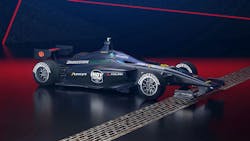An Autonomous Indy
The legendary drivers at the Indianapolis 500—names like Andretti, Foyt and Unser—are every bit a part of the annual Memorial Day weekend classic as the bricks across the finish line.
There is a similar race scheduled for Oct. 23 at the Indianapolis Motor Speedway. The prize money tops $1.5 million. The only thing missing will be the drivers.
As Machine Design reported this week, an autonomous car race at the Brickyard promises all the speed, with all of the driving skill taking place off the track itself. Teams will program a modified Dallara IL-15 car in an effort to outmaneuver the other driving teams. Schaeffler, in partnership with Schaeffler Paravan Technologie GmbH & Co. KG, will provide its Space Drive system to each team, including hardware, software, training and support.
It is every bit as much about winning, but just how the technology will work under race conditions will provide invaluable research for the continuing study of autonomous driving.
“We just don’t know what we don’t know,” said Noel Marshall, senior account executive for e-mobility with Schaeffler. “We’re having to go through a lot of simulation study of the hardware in the loop testing to make sure that once we do release these vehicles and these teams get the vehicle there won't be any accidents.”
That will be a challenge with race speeds hitting 200 mph, which is the same as a driver-managed Indy 500. Reaction time, whether human or autonomous, has to be almost instantaneous. “Another challenge that the teams face is making sure the communication exists without significant delays,” Marshall said. “If they have to pivot or if there’s a crash they have to go around, there’s no time to think about it; the system has to know how to react.”
The Thrill of “Driving”
This isn’t the first time technology has been used to enhance or expand the driving experience. Machine Design has written about how Dodge engineers wanted to allow the public to feel the experience of drag racing with its SRT Demons without actually letting drivers go from zero to 60 in 2.3 sec. Using a vehicle simulator and special actuators provided by Tolomatic, the driver could experience the thrill of speed, the 1.8 g’s of force at acceleration—even popping a wheelie—while standing in place.
At the other end of the speed spectrum is the biannual Bridgestone World Solar Challenge in Australia, which Machine Design also has reported on. Unfortunately, the 2021 event, scheduled for October from Darwin to Adelaide, was cancelled due to pandemic concerns. The research around solar power continues, but that will have to continue outside of the glare of the race attention—if not the sun itself.
About the Author

Bob Vavra
Editor Emeritus, Machine Design and Power & Motion
Bob Vavra is the former senior content director of Machine Design and Power & Motion.
